- Author: Kathy Keatley Garvey
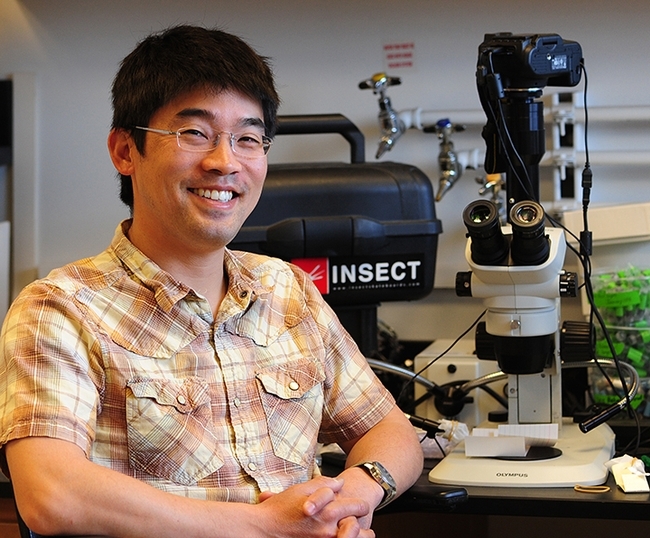
That's the abstract of UC Davis community ecologist Louie Yang's review article published June 26 in the journal, Current Opinion in Insect Science. Yang, a Department of Entomology and Nematology professor who researches monarch butterflies, suggests three broad guidelines for western monarch conservation.
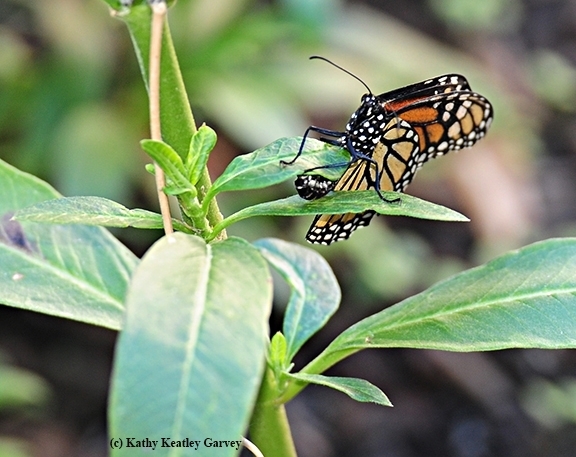
The western monarch population overwinters along the California coast. Estimated at 4.5 million in the 1980s, it has dropped significantly over the past five years, the professor related, noting an “86% single-year population decline in 2018, an overwintering population of less than 2000 butterflies in 2020, and an unexpected >100-fold increase in 2021."
Yang defined the western monarch population as occupying "a geographically distinct region of North America west of the Rocky Mountain...Ongoing climate change has made the western monarch range warmer, drier, and more prone to heatwaves, wildfires, and winter storms with complex effects on their ecology. Land development and changes in the structure of landscape mosaics have modified both the breeding and overwintering habitats of western monarch butterflies, changing the spatial distribution of resources and risks across their range. Shifts in agricultural and horticultural practice have changed the nature of potentially deleterious chemicals in the environment, including novel herbicides and insecticides."
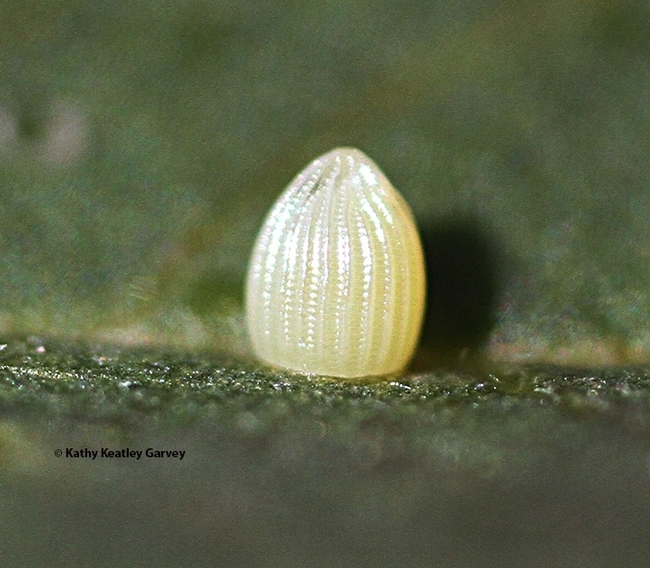
His three suggestions:
- "First, we should continue to support both basic and applied monarch research. This includes efforts to better understand fundamental aspects of monarch biology, studies to examine the ecological factors that limit monarch populations in the West and efforts to improve more targeted adaptive management and monitoring efforts. Basic research in monarch biology and ecology improves our understanding of this complex system and can inform conservation actions in profound and unexpected ways. In turn, applied research can address recognized gaps in knowledge that would otherwise limit available strategies for conservation planning and management."
- "Second, recognizing the limits of our current understanding, we should follow the precautionary principle to minimize the risk of counterproductive action. The complexity of this system makes it difficult to anticipate or assume future changes in behavior, species interactions or population dynamics. In practice, this may mean prioritizing efforts to better understand and facilitate existing mechanisms of ecological resilience and recovery over direct actions to manipulate or augment the population with less certain consequences. More broadly, this approach would probably emphasize common sense approaches to mitigate the widely recognized upstream drivers of global change (e.g., climate change and land use change), rather than those requiring a detailed understanding of their complex, interactive effects on species-specific ecologies further downstream."
- "Third, we should work to improve, protect and maintain the resources required throughout the complex monarch life cycle. In part, this likely means prioritizing conservation efforts that target the times and places that are likely to have the greatest positive effects, building on the common ground of available science. In the case of western monarchs, this includes protecting current and future overwintering habitats, the resources required for population expansion in the early season, and the resources required for the fall migration. Recognizing the potentially widespread and pervasive effects of pesticides, this could also mean efforts to develop more ecologically realistic and relevant metrics for the regulation of environmental chemicals."
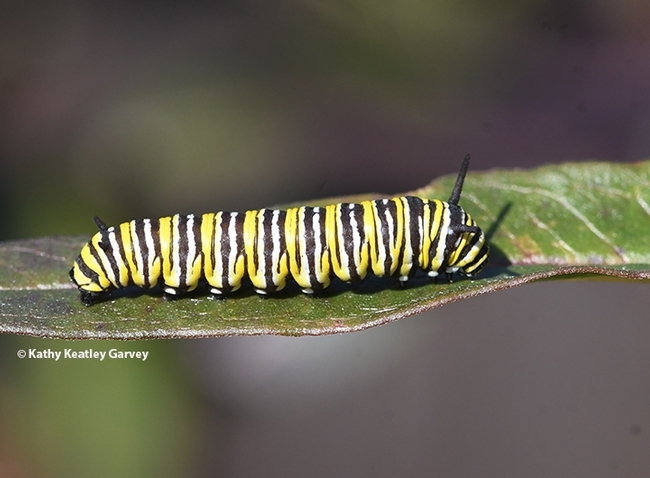
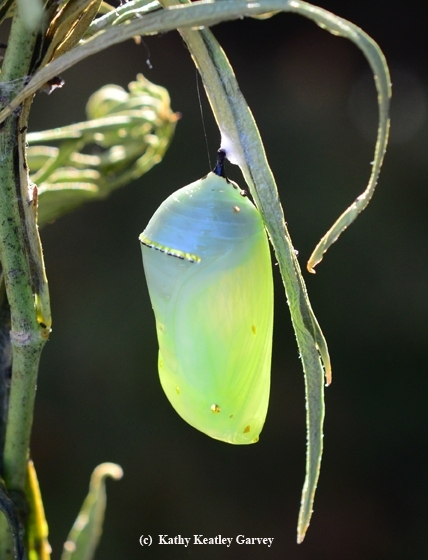
Editors of the journal, Current Opinion in Insect Science, describe it as "a new systematic review journal that aims to provide specialists with a unique and educational platform to keep up–to–date with the expanding volume of information published in the field of insect science."
Yang's research is supported by a National Science Foundation award. He was a guest on National Public Radio's Science Friday in February 2022. Listen to the interview here.
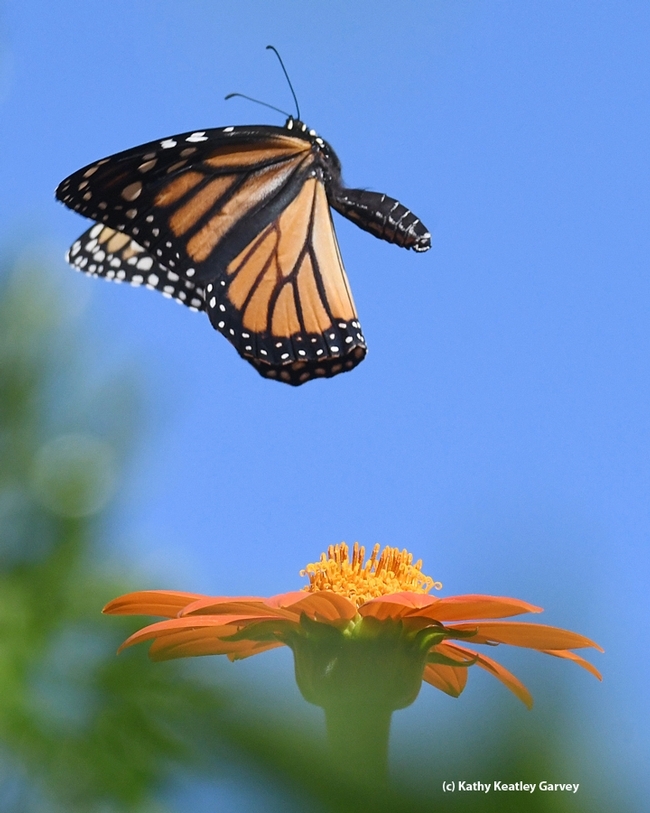
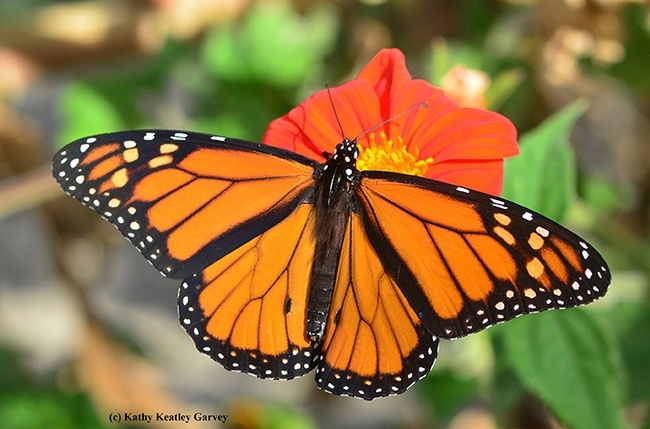
All year long, we've been waiting for those majestic monarchs to visit our pollinator garden in Vacaville, as they have in the past 10 years or so. One year (2020), they deposited more than 300 eggs on our milkweed.
But this year?
Zero. Zilch. Nada.
Where are you?
Dawn. Noon. Dusk.
Where are you?
Nothing has fluttered in and out except the Western tiger swallowtails, Gulf Fritillaries, fiery and common-checkered skippers, cabbage whites, buckeyes, mourning cloaks, and gray hairstreaks.
The milkweed grew, blossomed and went to seed. Ditto the Mexican sunflowers (Tithonia rotundifola). But the patch of Mexican petunia (Ruellia brittoniana) is thriving. The plant is a plucky perennial with purple, petunia-like flowers.
Purple, the color of royalty...a place where a monarch can reign supreme.
And that's exactly what happened today in the petunia patch at 3 p.m. A monarch fluttered in and sipped a little nectar. I almost missed it, as I was observing the Gulf Fritillary activity around the passionflower vine--the males chasing the females, the females laying eggs on the tendrils and leaves, and caterpillars munching the leaves.
The monarch didn't stay long, and I was too far way to move closer, but the Nikon Z-7 with its 105mm macro lens and its 45.7 megapixels, let me know that it was, indeed, one of those majestic monarchs we've been missing.
Hallelujah!
Washington State University entomologist and monarch researcher David James was right. On Aug. 31, he said I'd be seeing monarchs in a few weeks as they're leaving the Pacific Northwest (PNW) on their way to their overwintering sites along the California coast. (See Sept. 2 Bug Squad blog)
"The numbers we are seeing in the PNW this summer are consistent with numbers I've seen in summers past when theoverwintering population was approximately 250,000 as it was last winter," he related Aug. 31. "Last summer (2021) I verified approximately 60 Monarch sightings in the PNW. This summer, I have had approximately 500 verified reports. So, I think we have seen an 8-10 fold increase in Monarch numbers this summer in the PNW. The majority have been in Oregon, followed by Idaho, Washington and British Columbia. There are also positive reports of good numbers of Monarchs in Utah, Nevada and eastern California."
To track migratory monarchs, citizen scientists in the David James' research program affix a tag on the discal cell (underside of the hind wing). (The tag does not interfere with its flight.) This year James handed out 2000 tags to citizen scientists in southern Oregon.
Now, maybe we'll see another tagged traveler like the one we photographed in 2016. The scenario: One of his citizen scientists, Steve Anderson of Ashland, Ore., tagged a male monarch on Aug. 28, 2016 that stopped for nectar in our Vacaville pollinator garden on Sept. 5, 2016. The tag read “Monarch@wsu.edu A6093." It hung around for five hours. (See Bug Squad blog and WSU news story)
"So, assuming it didn't travel much on the day you saw it, it flew 285 miles in 7 days or about 40.7 miles per day," James told us back in 2016. "Pretty amazing. So, I doubt he broke his journey for much more than the five hours you watched him--he could be 100 miles further south by now."
Meanwhile, watch for monarchs! What to do if you see a WSU-tagged monarch? Photograph it, if you can, and contact David James at david_james@wsu.edu or the PNW Facebook page. Also, report any Monarch sightings to iNaturalist and Journey North.
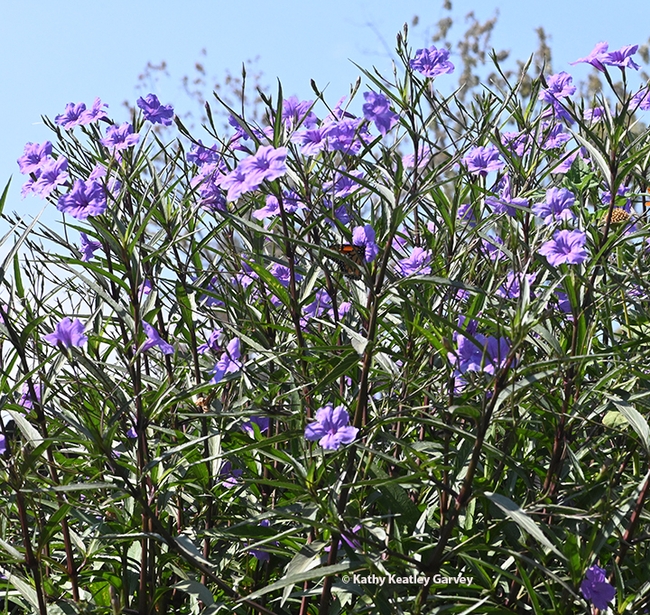
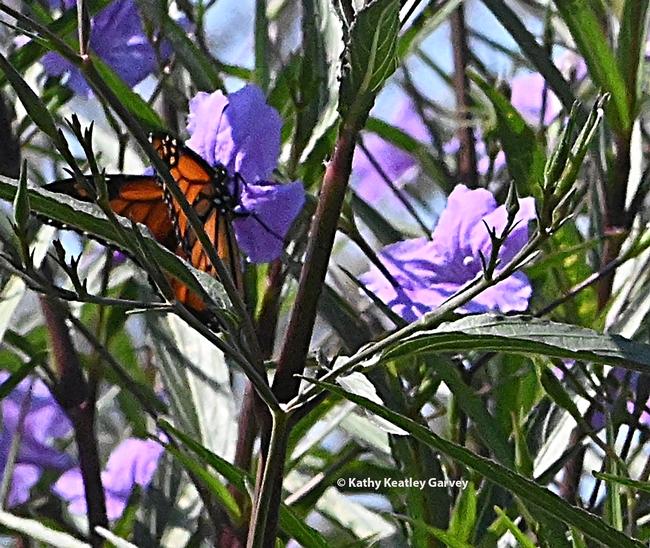
- Author: Kathy Keatley Garvey

That is, you saw a photograph of a Danaus plexippus ovipositing.
The image, by Joe Virbickis of Washington, Ill., won a medal at International Insect Salon, a highly competitive annual event coordinated by the Peoria Camera Club, Illinois and showcased by ESA. Each year photographers worldwide are invited to submit images of insects, spiders, and related arthropods (such as barnacles, crabs, lobsters, shrimp, centipedes and millipedes).
The 2021 Insect Salon drew a total of 256 images from photographers residing in Australia, Austria, Belgium, Canada, China, England, Hong Kong, India, Indonesia, Malaysia, Scotland, Taiwan, United Kingdom and the United Arab Emirates, as well as within the United States.
An image must receive a minimum of 13 points of the maximum 15 points to be accepted into the show, said Virbickis, chair of the Peoria Camera Club's Insect Salon committee. This year the judges accepted a little over 100 entries. The names of the winning photographers and their images are currently posted online.
ESA member Tom Myers, a Board-Certified Entomologist and noted photographer, chaired and emceed the Insect Salon showing at the Denver meeting.
The "Best of Show" medal went to Marcus Kam of Ipoh, state of Perak, Malaysia for "Bugs Love." Kam, an 11-year insect photographer, also won the medal for the "Best Image by a Non-ESA Member" for his "Sharing."
Other medalists:
- "Medal, Most Unusual," won by Albertus Nugroho of Jakarta, Indonesia, for "Super Ant In Action."
- "Medal, Best Story Telling," Dre Van Mensel of Tielen, Antwerpen, Belgium for "Fall Over."
- "Medal, Best by ESA Member," Tom Myers of Lexington, Ky for "Syrphid Fly Feeding."
- "Medal, Best by Peoria Camera Club Member," Joe Virbickis of Washington, Ill., for "Monarch Laying Eggs."
The monarch image? Here's the story behind the image.

"The story...I was searching our milkweeds for monarch caterpillars. I did not find any, but to my surprise, I encountered this monarch laying eggs. Fortunately, my movements to raise my camera did not startle her. I was able to focus and shoot a burst of six images before she fluttered off. Unfortunately, I could not find the eggs to gather them. I do not rear monarchs regularly. A couple years ago, I managed to find, harvest and raise four monarchs for release. It was quite exciting."
Virbickis created the image with his Canon 80D, and a 100-400mm Tamron lens, zooming in at about 200mm. "I have learned that monarchs can be skittish as they are sensitive to movement, sounds and shadows and I did not want to make any more movement than necessary."
A past president of the Peoria Camera Club and a repeat Insect Salon winner, Virbickis also won the same medal in 2012 and 2014 and has scored several acceptances over the years. "I have been interested in photography since age 12 and much of my collection is connected to travel (45 states and 7 countries)," Virbickis related. "I enjoy taking all sorts of images but wildlife, landscapes, nature, grandkids, travel and photojournalism are my favorites."
Virbickis worked as a school psychologist and director of special education from 1980 to 2015, and since then, has continued to work post-retirement as a part-time school psychologist. He has entered photographic competitions "within our local club, within our regional camera club association, in regional art fairs and some national/international contests (like the National Insect Salon). Over the years I've had a good deal of success in competitions and have sold several prints. I like to print my images, as I believe printing is the logical conclusion of the photographic process. It is very satisfying to hold the physical representation of my works and share that with others. Nothing beats watching someone get immersed in viewing one of my images and appreciate what I have captured. I have a very precious collection of prints of grandkids and the wildlife I have encountered over the years. I try to capture stories in my images and share those stories with others."

Known world-wide for his skills as a photographer and entomologist, Myers has traveled to all seven continents, sometimes under the most extreme circumstances, "to document our world and the people and wildlife in it." His images have appeared in USA Today, The Rachael Ray Show, National Geographic publications and Nature's Best, among others. They are also widespread on the Internet, as well as on calendars and in newspapers, textbooks, TV news broadcasts and scientific guides.
Myers, who has worked in the urban entomology field for several years, owns a pest management company in Lexington, KY. The National Pest Management Association and ESA extensively use his insect images. One recent image appeared on the Spring 2021 cover of American Entomologist. His images have won local, national, and international awards. His credits also include two invitational exhibits in Washington D.C. at the Smithsonian's National Museum of Natural History.

Among the two California entries accepted was one by yours truly, Kathy Keatley Garvey. It depicts two passion butterflies, Gulf Fritillaries (Agraulis vanillae), "keeping busy." Garvey, a communication specialist with the UC Davis Department of Entomology and Nematology and a member of ESA, quips that it is "insect wedding photography." An image of two bees, titled "Bee 4066" by Nan Carder of Lancaster, Ca., a retired registered nurse and active in the Photographic Society of America, was the other California entry accepted.
ESA, founded in 1889 and headquartered in Annapolis, Md., is the world's largest organization serving the professional and scientific needs of entomologists and others in related disciplines. Its 7000-members are in educational institutions, health agencies, private industry, and government.
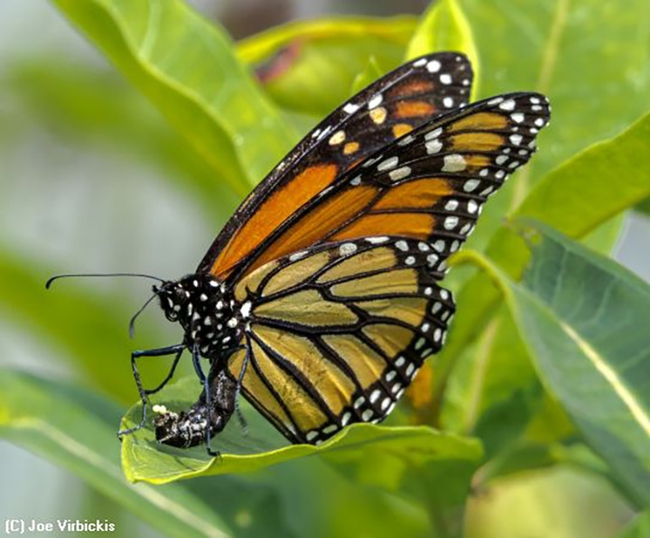
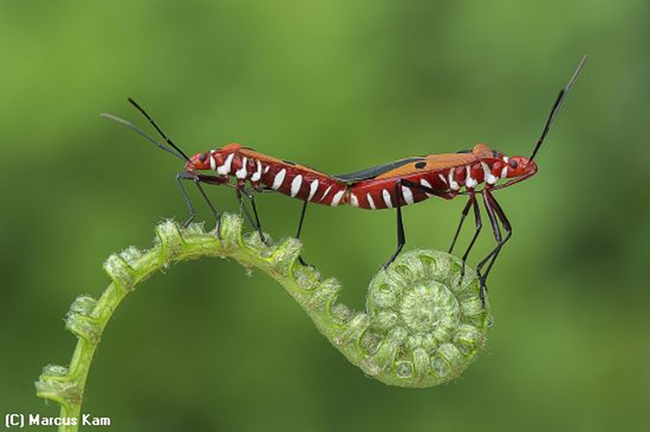
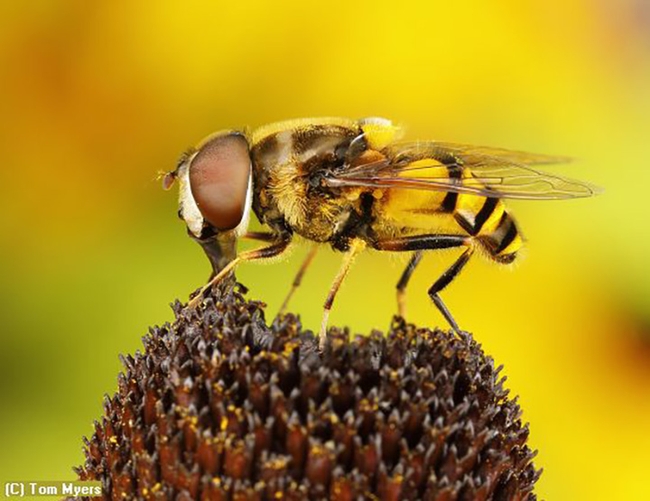
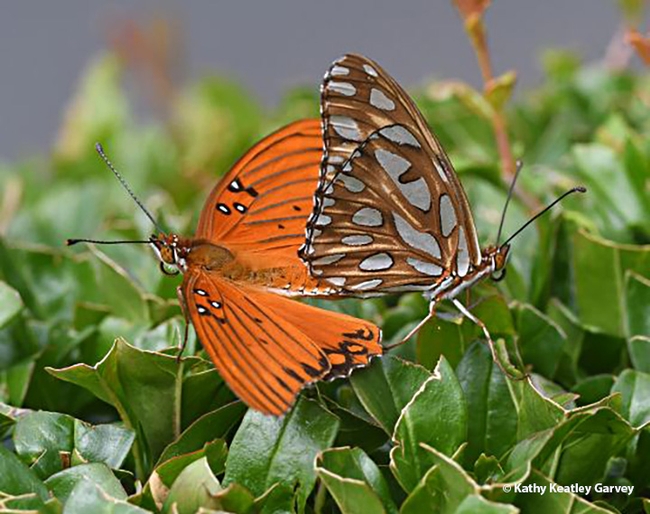
- Author: Kathy Keatley Garvey
Seen any monarchs lately?
No, not the British royal family: the monarch butterfly, Danaus plexippus.
Butterfly guru Art Shapiro, UC Davis distinguished professor of evolution and ecology who has monitored butterfly populations of dozens of species in the Central Valley since 1972, says it's a poor year for monarchs.
He saw one monarch on Sept. 26 in Davis, and one on Sept. 27 in West Sacramento, both Yolo County. "The coastward migration is apparently afoot...all 6 dozen of them..." he lamented.
Shapiro earlier described the monarch population as on life support. A look at this graphic on the inaturalist site helps tell the sad tale.
Maybe the U.S. Department of Fish and Wildlife will declare it an endangered species?
From its website: "On December 15, 2020, the U.S. Fish and Wildlife Service announced that listing the monarch as endangered or threatened under the Endangered Species Act is warranted, but precluded by higher priority listing actions. The decision is the result of an extensive status review of the monarch that compiled and assessed the monarch's current and future status. The monarch is now a candidate under the Endangered Species Act; we will review its status annually until a listing decision is made."
The first five paragraphs of their news release, issued Dec. 15, 2020: "After a thorough assessment of the monarch butterfly's status, the U.S. Fish and Wildlife Service (Service) has found that adding the monarch butterfly to the list of threatened and endangered species is warranted but precluded by work on higher-priority listing actions. With this decision, the monarch becomes a candidate for listing under the Endangered Species Act (ESA), and its status will be reviewed each year until it is no longer a candidate."
“We conducted an intensive, thorough review using a rigorous, transparent science-based process and found that the monarch meets listing criteria under the Endangered Species Act. However, before we can propose listing, we must focus resources on our higher-priority listing actions,” said U.S. Fish and Wildlife Service Director Aurelia Skipwith. “While this work goes on, we are committed to our ongoing efforts with partners to conserve the monarch and its habitat at the local, regional and national levels. Our conservation goal is to improve monarch populations, and we encourage everyone to join the effort.”
“The Monarch Joint Venture is committed to continuing its conservation efforts for monarchs. Each of our partners, and many other stakeholders, come to the monarch conservation table with different approaches, audiences, strengths and opportunities to make a difference. There is a role for everyone in monarch conservation,” stated Wendy Caldwell, Executive Director, Monarch Joint Venture.
"Over the past 20 years, scientists have noted declines in North American monarchs overwintering in Mexico and California, where these butterflies cluster. Numbers in the larger eastern population are measured by the size of the area they occupy. At a density of roughly 8.5 million monarchs per acre, it is estimated that the eastern population fell from about 384 million in 1996 to a low of 14 million in 2013. The population in 2019 was about 60 million. The western population, located in California, saw a more precipitous decline, from about 1.2 million in 1997 to fewer than 30,000 in 2019."
"In 2014, the Service received a petition to list the species and published a substantial 90-day finding in December 2014. In 2016, the agency began an in-depth status assessment, looking at the global population as well as focusing on monarchs in North America, where 90% of the world's population occurs."
Meanwhile, the tally of sightings in the Yolo-Solano area is troubling. Beyond troubling....
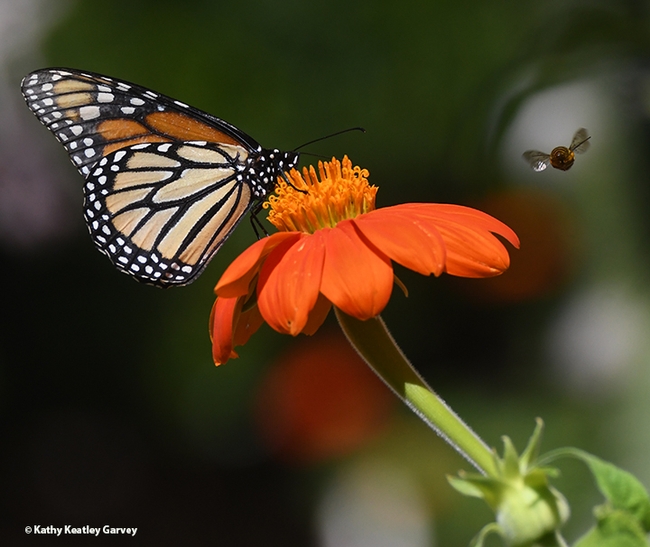
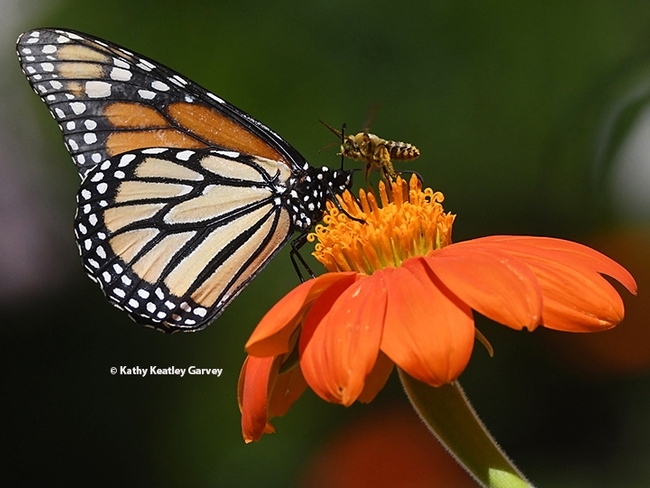
- Author: Kathy Keatley Garvey
It was July 3, 2020.
The male bees, Melissodes agilis, were getting quite territorial.
Every time a butterfly, a honey bee or another insect in our family's pollinator garden expressed an interest in foraging on the Mexican sunflowers, Tithonia rotundifola, a male Melissodes buzzed them.
"Get out of here!" he threatened. "I own these flowers. These are mine!"
What to do? I grabbed my Nikon D500 and 200 mm macro lens, adjusted the settings to 1/5000 of a second, f-stop 5.6, ISO of 800, and managed to get a shot of the menacing bee confronting a bewildered monarch.
Eye-to-eye. Antenna-to-antenna. Wing-to-wing.
What happened? The monarch quickly escaped the wrath.
And the bee? It buzzed off, only to return to target another insect.
"Get out of here! I own these flowers. These are mine!"
Another tiff on the Tithonia. Another round on the rotundifola.
Just another day in the pollinator garden.



